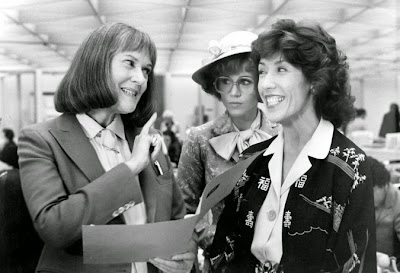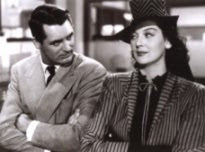To read the various obituaries/tributes about Margot Kidder, who sadly passed yesterday at age 69, one would assume that the only films she made were four "Superman" titles (between 1978-1987) and two horror movies, "Black Christmas" (1974) and "The Amityville Horror" (1979).
Sad indeed.
Kidder had 135 on-screen acting credits (including TV) when she died, the most recent in 2017, and while certain films made early in her career are what fascinate me, it is heartening to peruse those 135 titles and discover the interesting choices she made both pre- and post-"Superman" and how many times she returned to her native Canada to work with homegrown filmmakers there - Bob Clark, Donald Shabib, Robin Spry, Patricia Rozema, Gabrile and Jancarlo Markiw, Gary Ledbetter and Clement Virgo.
While I suppose that whatever Kidder accomplished on screen will forever be overshadowed by her turns in the "Superman" quartet (where she, inarguably, transformed Lois Lane into a charming, assertive, three-dimensional character), these forgotten Margot titles are what I admire:
"Gaily, Gaily" (1969) - It's jaw-dropping that none of the obits bothered to mention that Kidder made her film debut in Norman Jewison's hugely atmospheric adaptation of the Ben Hecht's roman à clef about his early days as a cub reporter in turn-of-the-century Chicago. Beau Bridges is wonderful as young Hecht (named Ben Harvey in both the book and Jewison's film) and he's paired attractively with Kidder as Adeline, the sweet prostitute he meets at Queen Lil's Whorehouse (with Melina Mercouri bigger-than-life as Queen Lil). Brian Keith is a standout as a besotted newsman and, as Pauline Kael, noted in her review, it's worth the price of admission just to hear Keith rasp out the words,
"You quack!," to a questionable doctor. As Jewison is Canadian, too, one can assume that he discovered Kidder on their home turf.
"Quacker Fortune Has a Cousin in the Bronx" (1970) - This disarming oddity - about an Irish guy who is perfectly happy collecting horse excrement (that's right) and selling it as fertilizer for flower gardens - was made just as star Gene Wilder was becoming an A-list player. The critics, more or less, indulged him and the film was something of an art-house sensation for a while. It was directed by India's Waris Hussein and, reportedly, there was no love between the filmmaker and Kidder.
"Sisters" (1972) - Kidder is brilliantly showcased here by Brian De Palma in his first tribute (the first of many) to Alfred Hitchcock, casting the actress as separated conjoined twins - one seemingly normal, the other apparently psychopathic (as is usually the case with movies about twins). There's a murder, observed from a window across the way by a reporter (Jennifer Salt) who, ignored by the police, opts to do her own investigation. Shades of "Rear Window," replete with a score by ... Bernard Hermann. Meanwhile, one of the twins attempts a cover-up.
"A Quiet Day in Belfast" (1974) - Kidder played twins again in this powerful drama about the violent confrontation between Irish "patriots" and British soldier in Belfast. Britain's Barry Foster (Hitchock's "Frenzy") stars with Kidder under the direction of Milad Bessada, another Canadian.
"The Great Waldo Pepper" (1975): An enjoyable Robert Redford-George Roy Hill collaboration, written by William Goldman, that is rarely referenced in critical analyses devoted to either man. (It's still available on DVD but not an easy find.) Redford plays an avid, charismatic flyboy with a knack for entertaining (and stirring up) the masses - a pilot who, in the early 1900s, takes up barnstorming, a stint that leads to work in the movies. Bo Svenson is memorable as Waldo Pepper's chief rival and, while this is something of a film about guys, it provides both Kidder and especially Susan Sarandon with terrific roles. The many landscapes and aerial stunts are beautifully captured by cinematographer Robert Surtees.
"92 in the Shade" (1975) - Novelist Thomas McGuane dabbled in movies in the 1970s, writing the script for Frank Perry's "Rancho DeLuxe" in 1975 (which he would
revamp a year later later for Arthur Penn as "The Missouri Breaks"). The same year, he wrote and directed "92 in the Shade," a small, solid but decidedly quirky film about a rivalry between Warren Oates and Peter Fonda, both of whom run fishing-charter businesses in Key West. There's a wealth of character actors here - Harry Dean Stanton, William Hickey, Sylvia Miles, Burgess Meredith, Louise Latham and Joe Spinell. Plus Elizabeth Ashley and Kidder. McGuane apparently met Ashley on "Rancho DeLuxe" where the two started a relationship, but by the end of "92 in the Shade," he and Kidder were involved. They married and had a daughter, Maggie. It was the first of Kidder's three marriages, the others to actor John Heard and French filmmaker Philippe De Broca.
"The Reincarnation of Peter Proud" (1975) - Unjustly ignored and, therefore, almost impossible to see, J.
Lee Thompson's unusual film is an existential road movie in which
Michael Sarrazin (another Canadian!) is the titular Peter Proud, an acedemic who initiates an impromptu journey after experiencing
flashbacks from seemingly another person's life -
or his previous life.

His driving takes him to Kidder who, in her most impressive screen
performance, plays an older women named Marcia Curtis whose late,
abusive husband Jeff seems to be alive/reincarnated in Peter. Marcia has a dark
secret and the presence of Peter/Jeff horrifies her. Complicating
matters is her daughter Ann (Jennifer O'Neill) who is attracted to
Peter, a feeling that's mutual and, in this disturbing, dream-like film,
implies incest. Kidder also plays the younger Marcia (opposite
Tony Stefano as Jeff) in flashbacks. It's a tour-de-force performance.
"Heartaches" (1980) - Another road movie - and a return to Canada for Kidder who worked with Don Shabib ("Going Down the Road") on this tale of a young woman named Bonnie (Annie Potts) carrying a baby that is not her husband's. (Robert Carradine is the husband.) Unable to face the reality of her situation, Bonnie hops on a bus and meets Kidder's flakey Rita and, well, eventually goes home with Rita. It's a slight, fizzy movie, elevated by the obvious, natural camaraderie between the two stars.
"Willie & Phil" (1980) - Paul Mazursky's unofficial remake of
François Truffaut's "Jules et Jim" casts Kidder in the plum Jeanne Moreau role, with Ray Sharkey (his promising career abruptly cut short by his early death) and Michael Ontkean (a promising leading man who almost became a star) as the two men in her life. Both love her, each in his own way, but there is also a vague attraction between the two men that goes beyond the usual friendship, an intimacy handled shrewedly by Mazursky but still not discreet enough for audiences at the time. It was shrugged off by the critics and dismissed by audiences. It's a title whose time has come for a serious re-evaluation.
Of her extensive TV work, there are two titles that I missed and would love to track down. In 1982, Kidder played Cherie, the Marilyn Monroe role, in a TV version of
"Bus Stop," adapted by its playwright, William Inge, and directed by Peter H. Hunt ("1776"). Tim Matheson was cast in the Don Murray role, Barry Corbin in the Arthur O'Connell part and Joyce Van Patten played the character originally essayed by Betty Field.
And in 1983, she played Eliza Doolittle to Peter O'Toole's Henry Higgins in George Bernard Shaw's "
Pygmalion," directed by Britain's Alan Cooke. Reader Kevin Barry forwarded a You Tube link to this version of "Pygmalion." The link is
here.
And then there was her Margot Kidder interpretation of Lois Lane...
Flawless.
Regarding Comments: All comments are enthusiastically appreciated but are moderated before
publication. Replies signed "unknown" or "anonymous" are not encouraged.
Please sign any response with a name (real or fabricated) or initials.
Be advised that a "name" will be assigned to any accepted post signed
"unknown" or "anonymous." Thank you.
~images~
(from top)
~Margot Kidder and Chistopher Reeve in a scene from "Superman"
~photography: Warner Bros. 1978©
~Beau Bridges and Kidder in a publicity shot for "Gaily, Gaily"
~photography: United Artists 1969©
~Kidder times two in "Sisters"
~photography: American-International 1972©
~Robert Redford and Kidder in "The Great Waldo Pepper"
~photography: Universal 1975©
~Kidder as the young Marcia in "The Reincarnation of Peter Proud"
~photography: Cinerama Releasing 1975©
~Paul Mazursky directing Ray Sharkey, Kidder and Michael Ontkean in "Willie & Phil"
~photography: Twentieth Century-Fox 1980©































